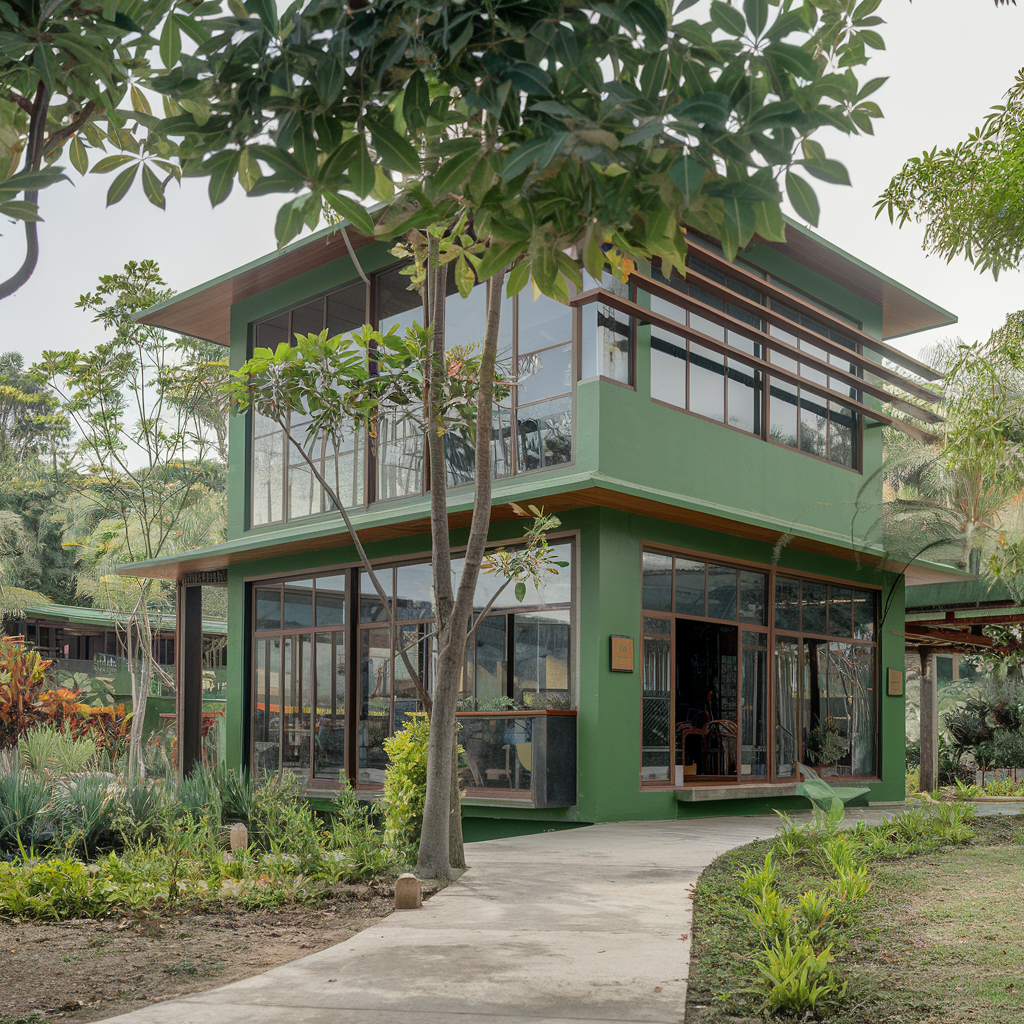In today’s world, living sustainably is more important than ever. We all want to reduce our environmental impact and build a greener future. Building your dream home with sustainability in mind is key. It not only cuts down on carbon emissions but also saves money on utilities and boosts your health.
The rise of green building practices is changing the way we live. By using sustainable design, you can make a home that looks great and is good for the planet. Choosing eco-friendly materials and adding energy-saving tech opens up endless possibilities for your dream home.
Key Takeaways
- Discover the benefits of sustainable living and eco-friendly homes
- Explore the latest green building practices and trends
- Learn how to reduce your carbon footprint and utility costs
- Understand the importance of energy efficiency and renewable energy solutions
- Discover the impact of sustainable design on your health and well-being
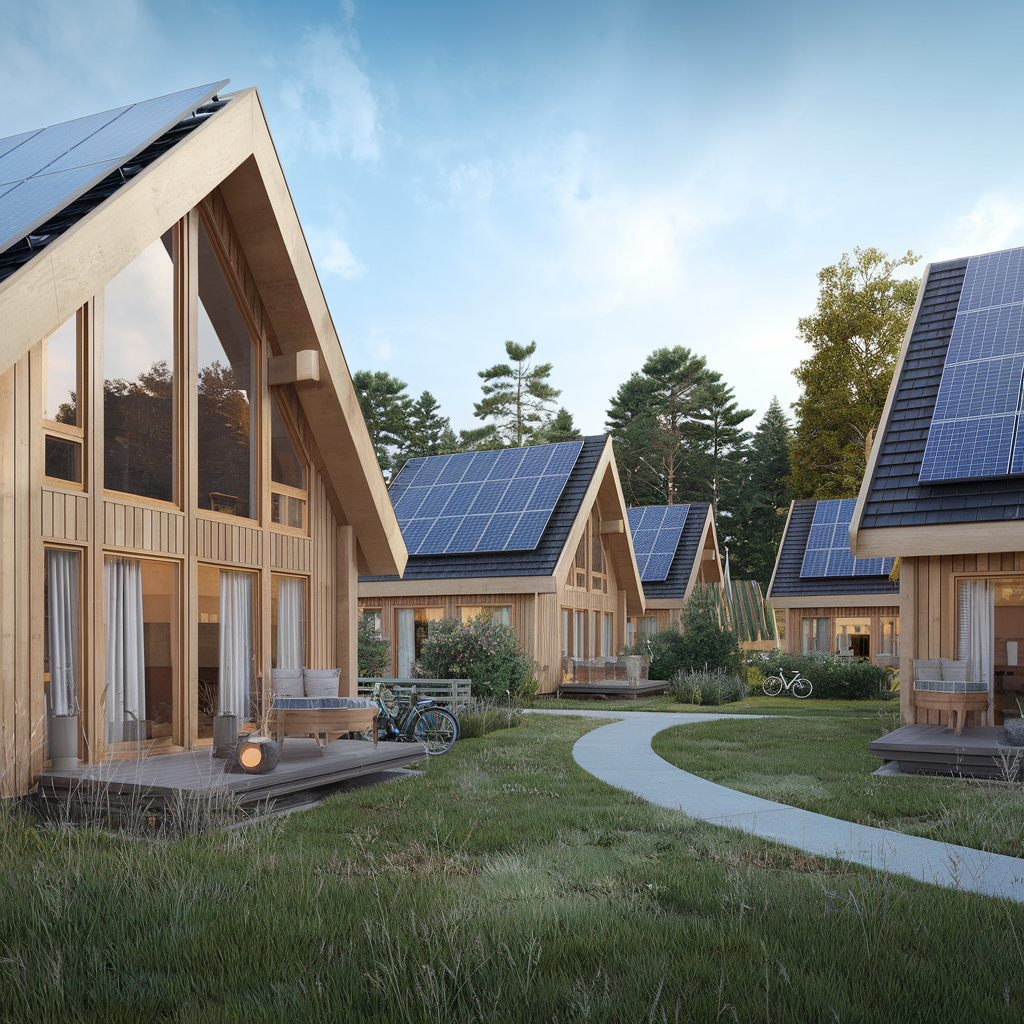
Understanding the Fundamentals of Sustainable Home Design
Making an eco friendly home is more than just looks. It’s about using less energy, saving resources, and being kind to the environment. Architects and builders follow key principles to make homes that are good for the planet.
Key Principles of Green Architecture
Green homes use materials that are good for the earth, efficient energy systems, and new building methods. They aim for lots of natural light, good air flow, and solar power. This way, homes look great and help the planet.
Benefits of Sustainable Home Design
- Less energy use and lower bills
- Better air and health
- Higher value and savings over time
- Less harm to the environment
Environmental Impact Assessment
Before building an eco friendly home, a detailed environmental check is needed. This looks at how the home might affect the local area, like water use and waste. Knowing this helps homeowners make choices that are better for the planet.
| Sustainable Home Design Principle | Description |
|---|---|
| Energy Efficiency | Using renewable energy, efficient appliances, and a well-insulated home to save energy. |
| Resource Conservation | Choosing eco friendly materials, using less water, and recycling to lessen the home’s impact. |
| Passive Solar Design | Designing the home to use the sun for heating and cooling, with big windows and thermal mass. |
By following sustainable design, homeowners can build homes that show their values and help the planet.
“Sustainable home design is not just about building a structure; it’s about creating a living environment that respects the planet and enhances the well-being of its occupants.” – Jane Doe, Architect
Essential Green Building Materials for Your Eco Friendly Home
Building an eco-friendly home starts with choosing the right materials. Options like reclaimed wood and recycled steel are great. They help reduce environmental harm and make your home healthier.
Reclaimed wood adds beauty and cuts down on environmental impact. It comes from old buildings, saving new trees. Bamboo is also a top pick. It’s strong, grows fast, and is perfect for floors and cabinets.
Recycled steel is a big deal in green building. It’s strong and can be used over and over. Plus, using low-VOC paints keeps your air clean by avoiding harmful chemicals.
| Green Building Material | Environmental Benefits | Applications |
|---|---|---|
| Reclaimed Wood | Reduces demand for new lumber, minimizes waste | Flooring, cabinetry, furniture |
| Bamboo | Rapidly renewable resource, durable and sustainable | Flooring, cabinetry, countertops |
| Recycled Steel | Endlessly recyclable, reduces energy-intensive production | Framing, roofing, appliances |
| Low-VOC Paints | Improved indoor air quality, reduced chemical emissions | Interior and exterior paint |
Using green building materials makes your home eco friendly and beautiful. It’s a step towards a greener future. Your home becomes a place of sustainability and comfort.
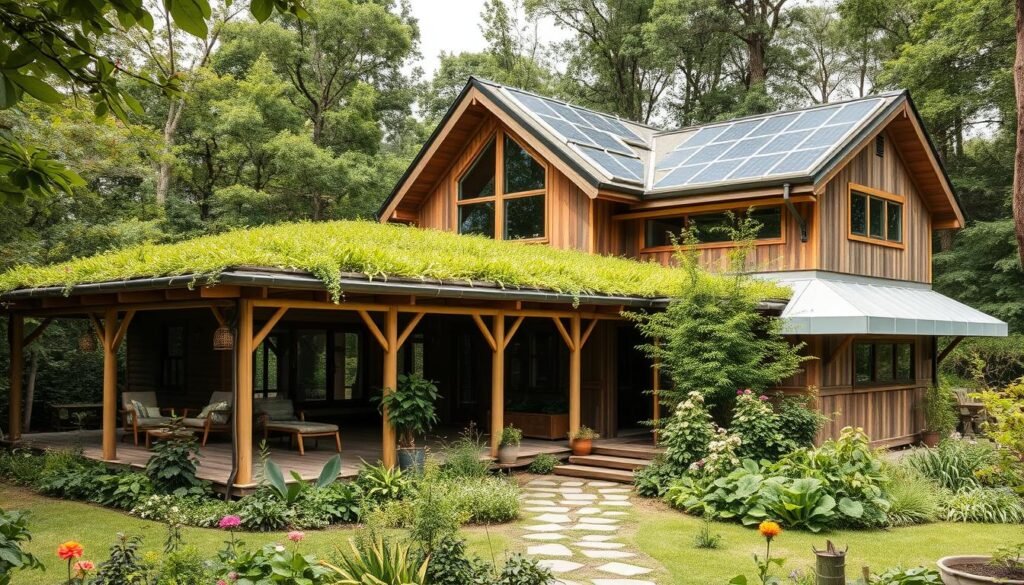
Smart Energy Solutions for Maximum Efficiency
Making your home eco-friendly is more than just looks. It’s about saving energy too. Smart energy solutions help cut down on carbon emissions and lower bills. You can use the sun’s power and smart home tech to make your home energy-smart.
Solar Panel Integration
Solar panels are a top choice for green homes. They turn sunlight into clean energy, lessening your need for the grid. Thanks to new tech, solar panels now save more energy and money than ever.
Energy-Efficient Appliances
Switching to energy-saving appliances is key for a green home. Choose appliances with the ENERGY STAR label. They use less energy than old ones, cutting down on your carbon footprint.
Smart Home Technology
Smart home tech has changed how we use energy at home. Smart thermostats and lights let you control energy use easily. With smart tech, you can keep your home energy-efficient and eco-friendly.
“Integrating smart energy solutions is a game-changer for eco-conscious homeowners. The combination of renewable energy, efficient appliances, and intelligent home automation can dramatically reduce your environmental impact while saving you money on utility bills.”
Water Conservation Systems and Solutions
In today’s world, living sustainably is key. Eco-friendly homes are a big deal for many. One important part of an eco-home is using water conservation methods. There are many ways to cut down on water use and protect our resources.
Rainwater harvesting is a great way to use nature’s power. It collects rainwater for things like watering plants and flushing toilets. This not only saves water but also cuts down on bills and supports sustainable living.
Greywater recycling is another smart move for water conservation in an eco friendly home. It takes used water from sinks and showers and makes it safe for plants. This cuts down on fresh water use and helps the environment.
Simple changes like using low-flow fixtures can also save a lot of water. These fixtures use less water but still work well. They’re a budget-friendly way to make any home more eco-friendly.
| Water Conservation Technique | Estimated Water Savings | Additional Benefits |
|---|---|---|
| Rainwater Harvesting | Up to 50% of total household water usage | Reduces strain on municipal water supplies, lowers utility bills |
| Greywater Recycling | Up to 30% of total household water usage | Reduces wastewater discharge, promotes sustainable irrigation |
| Low-Flow Fixtures | 20-30% reduction in indoor water consumption | Cost-effective, easy to implement |
By using these water conservation methods, homeowners can make a big difference. They can save money, reduce their environmental impact, and help their eco friendly home be more sustainable. With a bit of planning and investment, a water-conscious lifestyle is achievable.
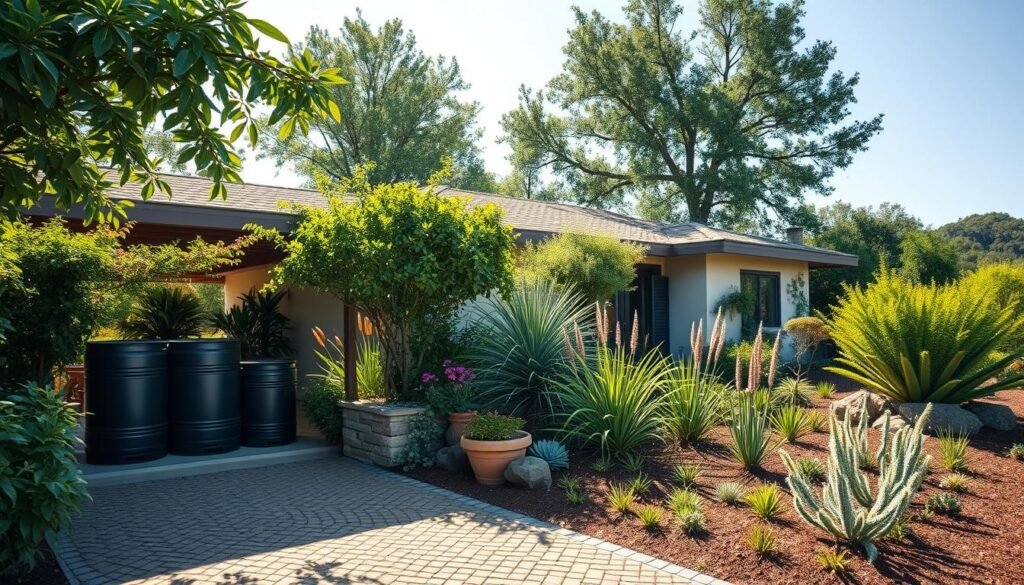
Natural Lighting and Ventilation Strategies
Building an eco friendly home is more than just the materials. It’s also about using natural light and air. By smartly designing your windows, you can save energy and live more sustainably.
Window Placement and Design
Where and how big your windows are matters a lot. Rightly placed windows can cut down on the need for artificial light. Good design can also help with heating from the sun. Think about adding overhangs, shades, and tinted glass to control light and heat.
Passive Solar Heating
- Place windows to catch sunlight and warm your home in cold months.
- Use materials like concrete or stone to absorb and release heat slowly.
- Choose windows with special coatings to keep the warmth in.
Air Flow Optimization
Good air flow is key for clean air and comfort inside. By understanding air movement, you can design your eco friendly home to use natural breezes. This might mean placing windows and vents for cross-ventilation or adding solar chimneys for airflow.

“Harnessing the power of nature is at the heart of sustainable home design. With thoughtful planning, you can create a home that is both comfortable and energy-efficient.”
Focus on natural light and air to lower your energy efficiency needs. This way, you’ll enjoy a greener, more sustainable living space in your eco friendly home.
Sustainable Landscaping and Organic Gardening
Creating an eco-friendly home isn’t just about the inside. It’s also about your outdoor spaces. By using sustainable landscaping and organic gardening, you can make your yard a vibrant, green haven. It will support local ecosystems and help you live more sustainably.
Using native plants is a big part of sustainable landscaping. These plants are tough, need less water, and fit your local climate well. Xeriscape gardening is another smart way to garden. It saves water and helps the environment.
Permaculture is all about natural systems. It can be used in your yard design. This method means your garden will be diverse, self-sustaining, and need less outside help.
Keeping your garden chemical-free is key. Avoiding synthetic fertilizers and pesticides protects wildlife. It makes your garden a safe place for pollinators and other helpful animals.
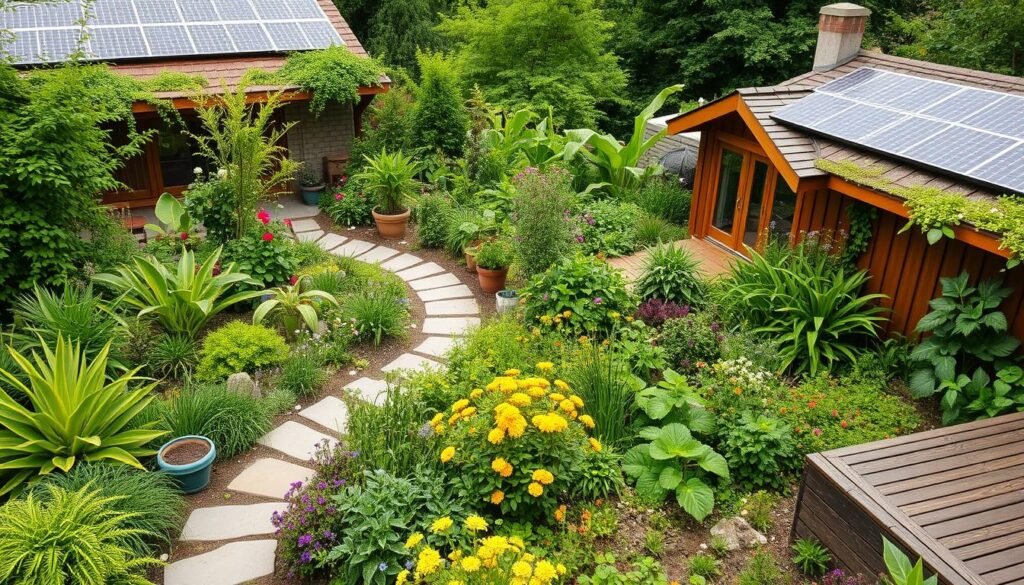
“Sustainable landscaping is not just about aesthetics – it’s about creating a harmonious relationship between your home, your yard, and the natural world around you.”
With some planning and eco-friendly choices, you can turn your yard into a green oasis. It will show your values and help create a better future.
Waste Management and Recycling Solutions
To make your home eco-friendly, you need a solid waste management plan. It’s not just about recycling. It’s about cutting down waste and finding new ways to handle it.
Composting Systems
Composting is key to managing waste well. It turns organic waste into soil for your garden. Composting makes food scraps and yard waste useful for your garden.
Recycling Station Design
Having a good recycling station in your home is important. It helps sort recyclables from trash. Recycling saves resources and cuts down on pollution. A clear recycling area makes it easy to recycle.
Zero-Waste Strategies
- Live simply to reduce waste. Adopt a sustainable living lifestyle.
- Choose reusable items over disposable ones. Use bottles, bags, and containers again.
- Set up a recycling system for many materials. This includes paper, glass, electronics, and more.
- Try upcycling and repurposing. Give old items a new life.
These strategies can greatly reduce your home’s waste. They help make the world a greener place.

Non-Toxic Materials and Indoor Air Quality
Creating an eco-friendly home is more than just saving energy and water. It’s also about using non-toxic materials and keeping the air inside clean. Household chemicals and VOCs can harm your health and well-being.
Choose sustainable, non-toxic cleaning products without harsh chemicals or synthetic smells. These products are better for the planet and your health. Also, pick building materials, furniture, and finishes that release fewer toxins. This way, your home will have clean, fresh air.
Good ventilation and air filters are key for clean indoor air. Get efficient HVAC systems, well-placed windows, and natural airflow designs. This ensures your home always has fresh, clean air. By focusing on non-toxic materials and air quality, you make your home a healthier place for your family.

Hello, I’m Jane, founder of Home Vibe Ideas. I’m here to inspire stylish Home Design, modern Smart Living, beautiful Outdoor Spaces, and creative DIY Projects to help you create a home that’s uniquely yours.
Disclosure: This post contains affiliate links. If you click on a link and make a purchase, we may earn a small commission at no additional cost to you. The content on this site was created with the help of AI technology.
